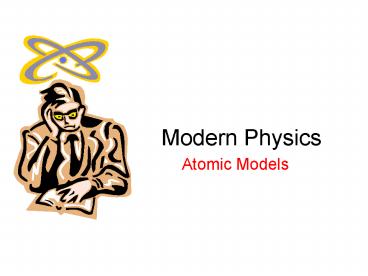Modern Physics - PowerPoint PPT Presentation
1 / 32
Title:
Modern Physics
Description:
Our ideas must agree with experimental evidence. Our ... Quintessence. Democritus 460-370 BC. Things are made up of extremely small particles called atoms. ... – PowerPoint PPT presentation
Number of Views:46
Avg rating:3.0/5.0
Title: Modern Physics
1
Modern Physics
- Atomic Models
2
Our ideas are based on imagination What does
an atom look like?
Our ideas must be translated into equations.
Our ideas must agree with experimental evidence.
Problem Ideas and equations can be difficult to
visualize.
LET THE HISTORY BEGIN.
3
Early Greeks
The early Greeks thought all matter was composed
of four elements.
Earthly Elements Earth Water Fire Air Heavenly
Elements Quintessence
4
Democritus 460-370 BC
Things are made up of extremely small particles
called atoms. Atoms cannot break or be destroyed
and they last forever.
5
John Dalton 1766-1844
Measured the weights of different elements and
listed them from lightest to heaviest. He used
symbols for elements rather than words
6
John Dalton 1766-1844
Everything is made of atoms, small hard
spheres. Atoms can not be subdivided, created,
destroyed. Atoms combine to make
compounds. Chemical reactions occur when atoms
combine. Gases are in constant motion, elastic
collisions.
7
Dimitri Mendeleev 1834-1907
Developed the Periodic Law which he made into the
Periodic Table of Elements.
8
J.J. Thomson 1856-1940
Discovered the electron (first subatomic
particle) when working with the cathode ray tube.
Measured the q/m ratio.
Calculated the mass of the electron using
Millikans experimental results.
9
Joseph Thomson 1856-1940
Plum Pudding Model
10
Radioactivity
1896 Henri Becquerel1898 Marie and Pierre Curie
Rutherford Three Types of Radiation Alpha,
? Beta, ? Gamma, ?
11
Ernest Rutherford 1899-1961
Conducts the famous Gold Foil Experiment.
Proposed a Planetary Model to replace Thomsons
model.
12
Gold Foil Experiment
Experimental Results Some ? deflected through
large angles. Indications of a large positive
charge. Some ? bounced back. Indications of a
dense nucleus.
Gold Foil Experiment
13
Rutherfords Planetary Model
Nucleus at the center (like the sun) Nucleus
contains all the positive charge Electrons in
circular orbits around nucleus (like the
planets) Electrons contain all the negative charge
Planetary Model
14
Problems with the Planetary Model
- Rutherfords model didnt explain atomic
absorption emission spectrum. - Another issue Electrons in circular orbits
- Must experience centripetal acceleration
- But accelerated charge emits radiation
- Radiation is energy
- So electrons must lose energy over time
- Eventually electrons should fall into nucleus
- So this model predicted an unstable atom
15
Niels Bohr 1885-1962
The electrons only move in stationary
orbits. Only certain orbits are stable (so only
certain orbits are permitted). In these
orbits, electrons do not emit radiation. Electron
s can move up and down between orbits.
16
Niels Bohr 1885-1962
- He didnt say how it was possible!
- Based his postulates on evidence from absorption
and emission spectra - Radiation is absorbed when an electron jumps up
from a lower orbit to a higher orbit. - Radiation is emitted when an electron falls
down from a higher orbit to a lower orbit.
17
How Do We Study Spectra?
Light passes through a slit and is then
dispersed, passing through a prism or diffraction
grating.
18
What is a Spectrum?
Three types of spectra.
Continuous
Bright-Line or Emission
Dark-Line or Absorption
19
Continuous Spectrum
Produced by a glowing hot solid
20
Bright-Line Spectrum
Produced by a hot gas. Also known as an emission
spectrum.
21
Dark-Line Spectrum
Produced by a cool gas intervening between you
and a hot solid The cooler gas absorbs photons of
specific wavelengths from the light as it passes
through. Also known as an absorption spectrum
22
Dark-Line Spectrum
Stars, when viewed from Earth with a
spectroscope, all yield absorption spectra.
23
Comparison
The absorption spectrum is a photo-negative of
the emission spectrum Dark lines (gaps) appear in
precisely the same location as corresponding
bright lines from the emission spectrum of the
same gas.
24
Summary
25
Why Study Spectra
Spectral lines yield much information about
structure, composition and energy changes.
Each chemical element radiates light in specific
wavelength combinations that are as distinctive
as fingerprints.
26
Back to Bohr 1885-1962
Electrons can only jump between orbits (energy
levels), cant land in between (quantum idea) n
is Bohrs principle quantum number or energy
level number. Numbered from nucleus outward.
27
Back to Bohr 1885-1962
Electrons jumping away from nucleus require a
photon to be absorbed Explains Dark-Line
spectra.
28
Back to Bohr 1885-1962
Electrons falling toward nucleus require a
photon to be emitted Explains Bright-Line
spectra.
29
Back to Bohr 1885-1962
Recall that spectra are unique. Spectra are the
result of electron transitions between
energy/orbital levels. Energy/orbital levels are
unique.
30
Back to Bohr 1885-1962
Nucleus has positive charge, and electrons have
negative charge. So the electrons have NEGATIVE
ENERGY compared to free electrons. Like falling
into a well When
you are below ground level, you have negative
gravitational potential energy.
31
Back to Bohr 1885-1962
The closer to the nucleus (the farther below
ground level) the larger the negative potential
energy. The farther from the nucleus (the closer
to ground level) the smaller the negative
potential energy. When is the energy equal to
zero?
32
Back to Bohr 1885-1962
Whats the relationship between energy level n
and energy?
Bright-Line Spectrum Activity







![Modern Physics [2] PowerPoint PPT Presentation](https://s3.amazonaws.com/images.powershow.com/8002705.th0.jpg?_=20160723081)
![L 36 Modern Physics [2] PowerPoint PPT Presentation](https://s3.amazonaws.com/images.powershow.com/7897333.th0.jpg?_=20210302064)
![L 35 Modern Physics [1] PowerPoint PPT Presentation](https://s3.amazonaws.com/images.powershow.com/7552279.th0.jpg?_=20160119094)
![L 37 Modern Physics [3] PowerPoint PPT Presentation](https://s3.amazonaws.com/images.powershow.com/7727835.th0.jpg?_=20160405031)
![L 34 Modern Physics [1] PowerPoint PPT Presentation](https://s3.amazonaws.com/images.powershow.com/7125701.th0.jpg?_=20150905079)
![L 38 Modern Physics [3] PowerPoint PPT Presentation](https://s3.amazonaws.com/images.powershow.com/8065013.th0.jpg?_=20160820129)
![L 33 Modern Physics [1] PowerPoint PPT Presentation](https://s3.amazonaws.com/images.powershow.com/7602675.th0.jpg?_=201602121011)



![Download Book [PDF] Hawley, J: Foundations of Modern Cosmology PowerPoint PPT Presentation](https://s3.amazonaws.com/images.powershow.com/10050367.th0.jpg?_=20240607117)













